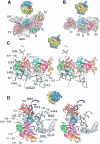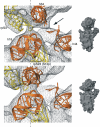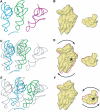Domain movements of elongation factor eEF2 and the eukaryotic 80S ribosome facilitate tRNA translocation
- PMID: 14976550
- PMCID: PMC380967
- DOI: 10.1038/sj.emboj.7600102
Domain movements of elongation factor eEF2 and the eukaryotic 80S ribosome facilitate tRNA translocation
Abstract
An 11.7-A-resolution cryo-EM map of the yeast 80S.eEF2 complex in the presence of the antibiotic sordarin was interpreted in molecular terms, revealing large conformational changes within eEF2 and the 80S ribosome, including a rearrangement of the functionally important ribosomal intersubunit bridges. Sordarin positions domain III of eEF2 so that it can interact with the sarcin-ricin loop of 25S rRNA and protein rpS23 (S12p). This particular conformation explains the inhibitory action of sordarin and suggests that eEF2 is stalled on the 80S ribosome in a conformation that has similarities with the GTPase activation state. A ratchet-like subunit rearrangement (RSR) occurs in the 80S.eEF2.sordarin complex that, in contrast to Escherichia coli 70S ribosomes, is also present in vacant 80S ribosomes. A model is suggested, according to which the RSR is part of a mechanism for moving the tRNAs during the translocation reaction.
Figures






Similar articles
-
Structures of modified eEF2 80S ribosome complexes reveal the role of GTP hydrolysis in translocation.EMBO J. 2007 May 2;26(9):2421-31. doi: 10.1038/sj.emboj.7601677. Epub 2007 Apr 19. EMBO J. 2007. PMID: 17446867 Free PMC article.
-
Three-dimensional cryo-electron microscopy localization of EF2 in the Saccharomyces cerevisiae 80S ribosome at 17.5 A resolution.EMBO J. 2000 Jun 1;19(11):2710-8. doi: 10.1093/emboj/19.11.2710. EMBO J. 2000. PMID: 10835368 Free PMC article.
-
Two crystal structures demonstrate large conformational changes in the eukaryotic ribosomal translocase.Nat Struct Biol. 2003 May;10(5):379-85. doi: 10.1038/nsb923. Nat Struct Biol. 2003. PMID: 12692531
-
Three-dimensional electron cryomicroscopy of ribosomes.Curr Protein Pept Sci. 2002 Feb;3(1):79-91. doi: 10.2174/1389203023380873. Curr Protein Pept Sci. 2002. PMID: 12370013 Review.
-
Elongation factors on the ribosome.Curr Opin Struct Biol. 2005 Jun;15(3):349-54. doi: 10.1016/j.sbi.2005.05.004. Curr Opin Struct Biol. 2005. PMID: 15922593 Review.
Cited by
-
Rotation of the head of the 30S ribosomal subunit during mRNA translocation.Proc Natl Acad Sci U S A. 2012 Dec 11;109(50):20391-4. doi: 10.1073/pnas.1218999109. Epub 2012 Nov 27. Proc Natl Acad Sci U S A. 2012. PMID: 23188795 Free PMC article.
-
P1 and P2 protein heterodimer binding to the P0 protein of Saccharomyces cerevisiae is relatively non-specific and a source of ribosomal heterogeneity.Nucleic Acids Res. 2012 May;40(10):4520-9. doi: 10.1093/nar/gks036. Epub 2012 Jan 24. Nucleic Acids Res. 2012. PMID: 22275522 Free PMC article.
-
Yeast ribosomal protein L40 assembles late into precursor 60 S ribosomes and is required for their cytoplasmic maturation.J Biol Chem. 2012 Nov 2;287(45):38390-407. doi: 10.1074/jbc.M112.400564. Epub 2012 Sep 20. J Biol Chem. 2012. PMID: 22995916 Free PMC article.
-
Using Yeast to Define the Regulatory Role of Protein Lysine Methylation.Curr Protein Pept Sci. 2020;21(7):690-698. doi: 10.2174/1389203720666191023150727. Curr Protein Pept Sci. 2020. PMID: 31642774 Free PMC article. Review.
-
Human alpha-defensins neutralize toxins of the mono-ADP-ribosyltransferase family.Biochem J. 2006 Oct 15;399(2):225-9. doi: 10.1042/BJ20060425. Biochem J. 2006. PMID: 16817779 Free PMC article.
References
-
- Agrawal RK, Heagle AB, Penczek P, Grassucci RA, Frank J (1999) EF-G-dependent GTP hydrolysis induces translocation accompanied by large conformational changes in the 70S ribosome. Nat Struct Biol 6: 643–647 - PubMed
-
- Ballesta JP, Remacha M (1996) The large ribosomal subunit stalk as a regulatory element of the eukaryotic translational machinery. Prog Nucleic Acid Res Mol Biol 55: 157–193 - PubMed
-
- Ban N, Nissen P, Hansen J, Moore PB, Steitz TA (2000) The complete atomic structure of the large ribosomal subunit at 2.4 Å resolution. Science 289: 905–920 - PubMed
-
- Beckmann R, Spahn CMT, Eswar N, Helmers J, Penczek PA, Sali A, Frank J, Blobel G (2001) Architecture of the protein-conducting channel associated with the translating 80S ribosome. Cell 107: 361–372 - PubMed
-
- Brunger AT, Adams PD, Clore GM, DeLano WL, Gros P, Grosse-Kunstleve RW, Jiang JS, Kuszewski J, Nilges M, Pannu NS, Read RJ, Rice LM, Simonson T, Warren GL (1998) Crystallography & NMR system: a new software suite for macromolecular structure determination. Acta Crystallogr D Biol Crystallogr 54 (Part 5): 905–921 - PubMed
Publication types
MeSH terms
Substances
Associated data
- Actions
- Actions
Grants and funding
LinkOut - more resources
Full Text Sources
Molecular Biology Databases
Miscellaneous

